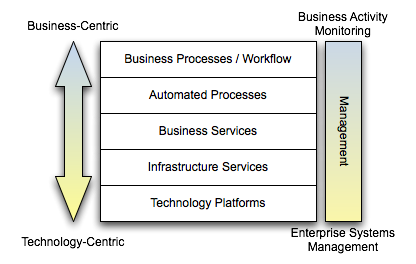 The management continuum
The management continuum
Mark Palmer of Apama continued his series of posts on myths around the EDA/CEP space, with number 3: BAM and BPM are Converging. Mark hit on a subject that I’ve spoken with clients about, however, I don’t believe that I’ve ever posted on it.
Mark’s premise is that it’s not BAM and BPM that are converging, it’s BAM and EDA. Converging probably isn’t the right word here, as it implies that the two will become one, which certainly isn’t the case. That wasn’t Mark’s point, either. His point was that BAM will leverage CEP and EDA. This, I completely agree with.
You can take a view on our solutions like the one below. At higher levels, the concepts we’re dealing with are more business-centric. At lower levels, the concepts are more technology-centric. Another way of looking at it is that at the higher levels, the products involved would be specific to the line of business/vertical we’re dealing with. At the lower levels, the products involved would be more generic, applicable to nearly any vertical. For example, an insurance provider may have things like quoting and underwriting at the top, but at the bottom, we’d have servers, switches, etc. Clearly, the use of servers are not specific to the insurance industry.

All of these platforms require some form of management and monitoring. At the lowest levels of the diagram, we’re interested in traditional Enterprise Systems Management (ESM). The systems would be getting data on CPU load, memory usage, etc. and technologies like SNMP would be involved. One could certainly argue that these ESM tools are very event-drvien. The collection of metrics and alerts is nearly always done asynchronously. If we move up the stack, we get to business activity monitoring. The interesting thing is that the fundamental architecture of what is needed does not change. Really, the only thing that changes is the semantics of the information that needs to get pushed out. Rather than pushing CPU load, I may be pushing out the number of auto insurance quotes requested and processed. This is where Mark is right on the button. If the underlying systems are pushing out events, whether at a technical level or at a business level, there’s no reason why CEP can’t be applied to that stream to deliver back valuable information to the enterprise, or even better, coming full circle and invoking some automated process to take action.
I think that the most important takeaway on this is that you have to be thinking from an architectural standpoint as you build these things out. This isn’t about running out and buying a BAM tool, a BPM tool, a CEP tool, or anything else. What metrics are important? How will the metrics be collected? How do you want to perform analytics (is static analysis against a centralized store enough, or do you need dynamic analysis in realtime driven by changing business rules)? What do you want to do with the results of that analysis? Establishing a management architecture will help you make the right decisions on what products you need to support it.

Violent agreement here, Todd, including your last point about “the most important takeways…” is a great one. In fact, it might serve as the basis of my next myth, if you don’t mind!
If you follow Mark’s blog, you’ll find that his next myth was that we shouldn’t think architecture first. If you’re reading this blog entry and thinking that I’m saying we should think architecture first, that’s not quite accurate. You do need to have goals and requirements first that then guide architecture, which in turn guides product design/selection, in that order.
[…] business activity monitoring, and business intelligence start to come together, as I’ve discussed in the past. I’ve seen one company take metrics from a BPM tool and placing them into their data […]
[…] A bit later in the podcast, Joe mentioned a conversation with Rourke earlier in the day, commenting that “predictive analytics, which is a subset of business intelligence (BI), is now moving into the systems management space.” This sounds very familiar… […]